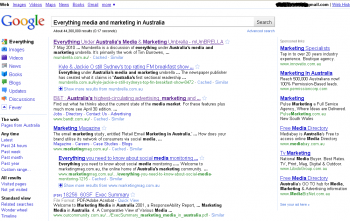Google changes mean brands need to increase focus on content
Last week saw major changes in the way Google looks, and in the results it produces. In this guest posting, Andrew Hughes argues that Australians brands will miss major opportunities if they do not make use of the new tools it offers
Almost every internet user in Australia will now have seen the updated Google search results pages known as the “Jazz interface”, and will no doubt have their own thoughts on how it will change the way that they search the web.
 With the more prominent News, Blog, Videos and Image search options, there are now more opportunities for users to refine their search results, based on their unique search preferences.
With the more prominent News, Blog, Videos and Image search options, there are now more opportunities for users to refine their search results, based on their unique search preferences.
Since the end of last month, a major update of Google’s search infrastructure has also been taking place, with the roll-out of the much awaited changes known as the Caffeine update. These changes should enable Google to improve the search result relevancy through the greater understanding of website authority, reputation and at the same time will enable the deep indexing of content where previously it has been limited.


Good update and good checklist. Places is quite a powerful upgrade. And another thing is that I think outsourcing these updates wouldn’t be too expensive and would produce a good ROI. (No, we don’t do this work, not a plug just a thought.)
Walter @g2m
http://xeesm.com/walter
Great tips Andrew, I think companies assume their SEO begins and ends with Adwords and don’t even consider their content or site infrastructure
Thanks for helping “non search” people . Your #1 is especially interesting … wondering if that will mean less people will want to guest post on blogs/other sites. Also what will it do to cross posting the same post?
Thanks for the feedback. Glad that it has been useful.
@Mandi – most people miss that if a brand is present in both AdWords & Organic Click-Though rate increases by 7% according to Google. (a “combined click-through rates are 5.1% higher when paid and organic listings are present simultaneously than when only the organic listings are present.” according to Nov. 09 Study by New York University’s Leonard N. Stern School of Business)
@Toby – I think that publishing first on your own website (even though Google says that they can work out who the originating author is) and then building Canonical Authority/Links back to your site is advisable:
http://googlewebmastercentral......omain.html
/y0z
Isn’t it weird how quietly Google introduces product upgrades. Every other product I can think of makes a big deal about the smallest thing (“NOW!!! In new FAMILY size!!!!!).
Google pretty much just slides ’em in.